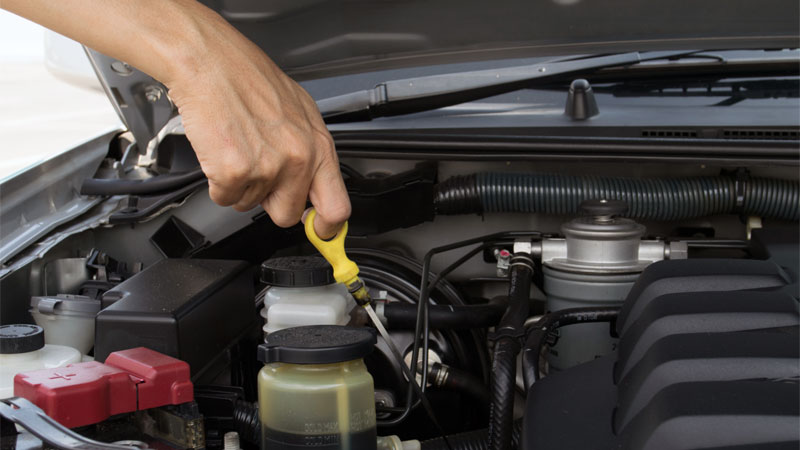Transmission fluid is the lifeblood of your car’s transmission system. Just like the engine oil lubricates the engine, transmission fluid lubricates the gears, bearings, and other moving parts within the transmission. Its purpose is to reduce friction and wear, prevent overheating, and clean away any contaminants. Adding the right transmission fluid at the proper intervals is essential for the smooth and efficient operation of your vehicle.

Image: xnoxygo.cluster029.hosting.ovh.net
Understanding Transmission Fluid
Transmission fluids are typically reddish in color and have a slightly oily texture. They contain a blend of base oils, additives, and detergents that each play a vital role in ensuring optimal transmission performance. When transmission fluid is new, it’s transparent and free of contaminants. However, as it circulates through the transmission, it gradually accumulates dirt, metal shavings, and other particles. Over time, this can lead to a decrease in the fluid’s lubricating properties and can compromise the transmission’s health.
When to Add Transmission Fluid
The frequency with which you need to add transmission fluid depends on the type of transmission in your car. Manual transmissions generally require less frequent fluid changes compared to automatic transmissions. Consult your car’s owner’s manual for specific recommendations, as the intervals can vary between different makes and models.
Some common signs that may indicate a need to add transmission fluid include:
-
Leaking transmission fluid: Look under your car for signs of reddish fluid spots on the ground.
-
Difficulty shifting gears: The transmission may feel hesitant or not shift smoothly between gears.
-
Slipping gears: The transmission may intermittently slip out of gear while driving.
-
Overheating transmission: In severe cases, a lack of sufficient transmission fluid can cause the transmission to overheat, leading to reduced performance or even failure.
How to Add Transmission Fluid
Adding transmission fluid is a relatively straightforward task that can be performed by most DIYers with basic tools and a few simple steps:
-
Gather the necessary tools: You will need a new bottle of transmission fluid (check your owner’s manual for the recommended type), a funnel, and a rag.
-
Locate the transmission dipstick: Pop open your car’s hood and locate the transmission dipstick, which is usually marked with a red or yellow handle.
-
Check the fluid level: Pull out the dipstick and wipe it clean with a rag. Reinsert it fully and then pull it out again. Check the fluid level on the dipstick against the indicated markings. If the fluid level is below the lower limit, your transmission needs more fluid.
-
Add transmission fluid: Insert the funnel into the transmission dipstick tube and slowly add transmission fluid. Avoid overfilling, as this can cause transmission problems.
-
Recheck the fluid level: Insert and remove the dipstick to check the fluid level again. Repeat until the fluid reaches the proper level.
-
Clean up: Replace the dipstick and wipe away cualquier excess fluid that spilled around the dipstick tube.

Image: schnautz-mezquita.blogspot.com
Types of Transmission Fluid
When adding transmission fluid, it’s important to use the type specified in your car’s owner’s manual. Different types of transmissions require different types of transmission fluid. The most common types include:
-
Automatic Transmission Fluid (ATF): Used in automatic transmissions. It contains specific friction modifiers and additives to ensure smooth gear shifting and protect against wear.
-
Manual Transmission Fluid (MTF): Used in manual transmissions. It has a higher viscosity and friction coefficient to withstand the higher forces and loads experienced in manual transmissions.
-
Continuously Variable Transmission Fluid (CVTF): Used in CVTs. It is specially formulated to provide the necessary lubrication and protection for the unique design of CVTs.
Transmission Fluid Maintenance Tips
Regularly checking and adding transmission fluid is crucial for maintaining optimal transmission performance and longevity. Here are some additional tips to help keep your transmission running smoothly:
-
Regular fluid changes: While adding fluid can temporarily address low fluid levels, it doesn’t replace the need for regular fluid changes. A complete transmission fluid change should be performed according to the manufacturer’s recommended interval.
-
Use the right transmission fluid: Always use the type of transmission fluid specified in your car’s owner’s manual. Using the wrong type of fluid can lead to transmission problems.
-
Check for leaks: Regularly inspect your car for any signs of transmission fluid leaks. Even a small leak can lead to a significant loss of fluid over time.
-
Avoid overheating: Don’t push your car too hard, especially in hot weather, to avoid overheating the transmission.
-
Listen for noises: If you hear unusual noises coming from your transmission, such as grinding or whining, have it checked by a mechanic as soon as possible.
Can I Add Transmission Fluid To My Car
https://youtube.com/watch?v=L1ncMR1QVmI
Maintaining a Healthy Transmission
By following these guidelines for adding and maintaining transmission fluid, you can significantly improve the lifespan and performance of your car’s transmission. Remember, a well-maintained transmission translates to smoother gear shifts, better fuel economy, and a more enjoyable driving experience.


/GettyImages-1303637-two-way-mirror-57126b585f9b588cc2ed8a7b-5b8ef296c9e77c0050809a9a.jpg?w=740&resize=740,414&ssl=1)


